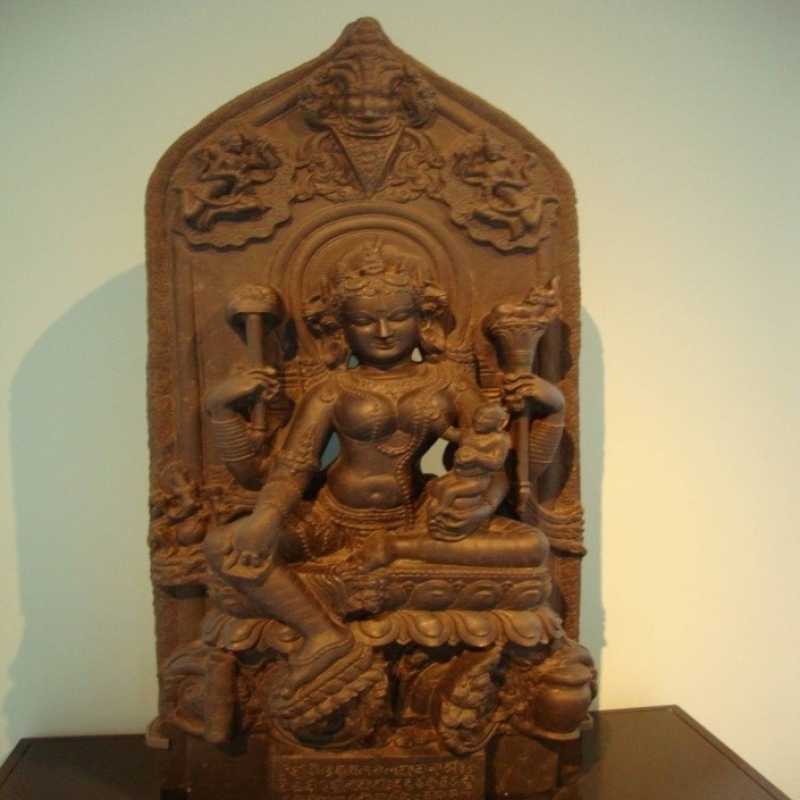Introduction
Image inscriptions belong to the category of donative records which in itself forms a class of epigraphs. On the one hand, there are royal donative records which are purely eulogistic in content; they record some donation or serve as a memorial for any occasion. Then there are private donations which are purely of a religious character, inscriptions engraved on metal or stone images form a large portion among them; they record the dedication of images on which they used to be inscribed. There are still other types of donative records, often inscribed on shrine walls, gateways, railings, etc. Image inscriptions are basically votive in nature since the images are donated on the fulfilment of a vow.
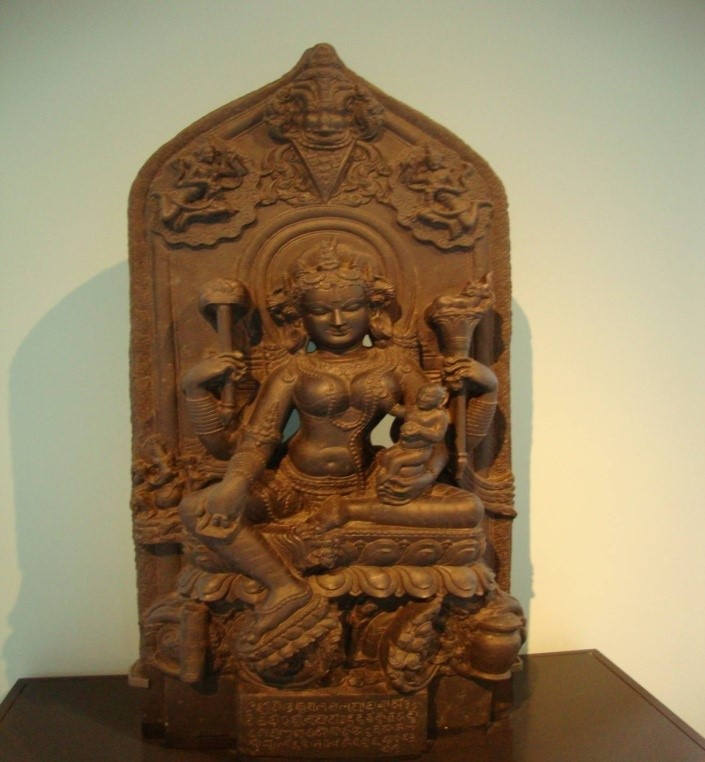
Content of the Image Inscriptions
Images were manufactured by the craftsmen at the request of the devotee. Image inscriptions are generally brief in nature, often consisting of one or two lines, or just the name of the donor. Numerous such instances are found among the inscriptions at Buddhist stupa sites like Sanchi and Bharhut. A twelfth-century stone image of Tara (now preserved in the Victoria and Albert Museum, London) carries the inscription ‘Sri Valachandrasya’ on its pedestal. This suggests that it was donated by a person named Valachandra, who, however, did not care to provide any further details regarding himself. On the other hand, some image inscriptions may carry a detailed reference to the donor like the donor’s name, title, occupation and place of residence or origin, the purpose and names of the relatives and associates of the donors who are to partake of its benefits.
Places of Engraving on an Image
On an image, the inscription may have been engraved on the stele or backslab, at the pedestal or even behind the image. The inscription of the Patna yaksha image is on the shoulder of the statue.[1]

In case of Buddhist images, the inscription may be written on the halo around the deities’ head. Most Buddhist stone images from Magadha are inscribed with the classical formula Pratītya samutpāda gāthā ye dharmā hetu prabhavā hetuṃ teṣāṃ tathāgato hyava dattesāṃ ca yo nirodhae vāmvādī mahāśramaṇaḥ (meaning that things arise in dependence of causes and cease when the causes are no longer present). Often this formula is seen in the upper part of the image where it is incised on a curved line running parallel to the edge of the nimbus, and thus around the head of the Buddha or the deity, as if emanating from them. In later examples the usual practice was to record the donation on the pedestal of the statue. Such pedestal inscriptions are common in Brahmanical, Buddhist and, especially, Jain traditions.
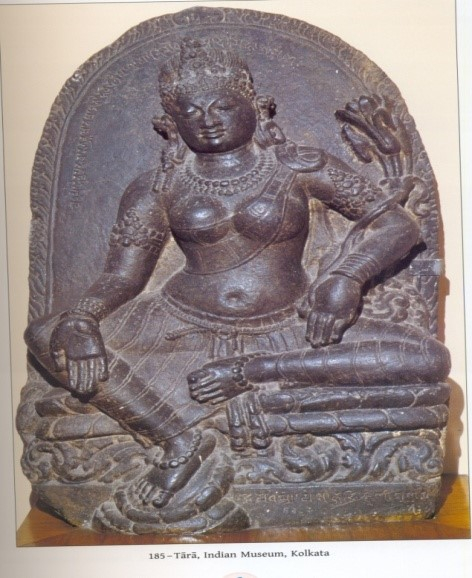
Regarding image inscriptions, the availability of space is an important factor influencing the content of the text. The donor has to give his details in a limited space and thus the details he/she chooses to give assume that much more significance. The key to understanding the context of the inscriptions lies in what the donor considers to be important for preserving and proclaiming his identity to the present and future residents and visitors of the establishment. For instance, persons travelling from distant places tried to mention the place of their origin since that would easily connect them to their country and make it easier for other visitors from their homeland to recognise who came before them. From the Buddhist monastery of Kurkihar, 28 kilometres from Gaya in Bihar, we have a large number of image inscriptions recording that their donors, both monks and nuns, came from Andhravishaya, Cholikavisaya, etc. Since these are likely to have been in the Andhra region or the territory of the Cholas in the Kaveri valley, it indicates the movement of hosts of monks from the south to the Kurkihar Monastery in Bihar.
The Practice of Donation of Inscribed Images
Initially the practice of donation of images was common among the Buddhists and Jains. The beginning of the tradition of donation of inscribed images has been traced from the Kushana period, second century CE, when images of the Buddha and Bodhisattvas became prevalent. For example, we may refer to the image of Maitreya Buddha from Gandhara (52–53 CE) and the Sarnath Buddhist image inscription of Kaniska I dated 81 CE. These are the earliest examples of inscribed images.
At a later period, donation of images became common in the Brahmanical religions also. From the fourth century, installation of images became widely prevalent. A large number of image inscriptions are found in eastern India, including Bihar, Odisha, West Bengal and Bangladesh. Often, they are found in monastic sites where they used to be donated on the fulfilment of a vow or manasika. R.C. Hazra has dated the sections on the consecration of images of the major Puranas between 550 to 1100 CE. This indicates that the donation of images at sacred places became popular during this period. In fact, installation of images came to be a shortcut method for acquiring religious merit. Religious centres like Nalanda, Kurkihar and Champa in south Bihar became favourable places for donation of images.
Dating of the Image Inscriptions
It is thus clear that image inscriptions might be both dated and undated. Sometimes the images bear dates in well-known eras, such as the Saka/Vikrama Samvat, or the regnal year of the ruler of the area. In some cases, the name of the reigning king has been mentioned along with his regnal year in which the donation was made. For example, an image of Hariti from Nalanda refers to the reign of Devapala at the very beginning.[2] Such dated sculptures help us, largely, in understanding the evolution of art styles. Susan Huntington has attempted to reconstruct the development of the Pala-Sena schools of sculptures on the basis of the dated sculptures of the Pala-Sena era.
Apart from the dated images, a large number of images carry inscriptions without any date or reference to the ruler. In such cases their period can be determined on the basis of stylistic features of the image as well as palaeographic features of the inscription. Thus, a proper understanding of an inscribed sculpture requires the joint input of both an art historian and an epigraphist.
Understanding the Significance of Image Inscriptions
The geographical distribution of the images donated by various occupational and social groups may be studied in order to understand the role of different craftsmen in the context of a religious establishment or a locality. Although while studying image inscriptions we have to keep in mind that they are portable in most cases and their provenance is not always a dependable source for drawing geographical inference. Still, in a few cases where we have reference either to the place of residence of the donor or the place of donation, these can be useful for understanding the connectivity and the relevance of the establishment to the donor. This may also provide information on trade routes and urban centres since images were often donated by merchants moving through trade routes towards market centres. An attempt may be made towards locating the images donated by occupational groups, implication of their geographical distribution, if any, and understanding the networks/connectivity of the places of donation with other areas. Together with this we may also try to investigate or understand the preference for particular religious faiths, gods and goddesses among occupational groups.
Depiction of Donors on the Pedestal of Images
In a few cases, we have representations of the donors and their families on the pedestal. G. Bhattacharya points out that normally the danapati (donor of the image), either alone or with family, is shown on the pedestal of Pala images. Tarasena, a danapati depicted in a rare image from a private collection in Patna, has a striking resemblance with Jambhalamitra, the donor of a Ganesa image found at Mandhuk, a village in Kumilla, Bangladesh.[3] Jambhalamitra is depicted there with his family. He is shown as bearded, corpulent and holding a garland in his hands, looking exactly like Tarasena. Bhattacharya cited other cases of depiction of danapatis, mostly they are in couple, none is represented with the full family; most of them resemble Tarasena with a beard and hair-do.[4] The commonality in the representation of the donor definitely points to some sort of standardisation; which again is possible if the images, under concern, were manufactured by a particular family or group of craftsmen in a particular area. This is true in the case of south-eastern Bengal. The danapati image, described by Bhattacharya, could have been made by the same group of artists who made the Ganesa image from Mandhuk.
The social background of donors of images is an interesting subject of study, and several scholars are engaged in this field of research. G. Schopen’s detailed study of donative inscriptions from various Buddhist sites indicates that the monks, and not the laity, played a vital role in the installation and worship of images. At Sarnath, the images donated by monks were twice as many as those donated by the laity. At Kanheri, none of the 18 donations of images was made by the laity. At the Ajanta caves, 94 per cent of images had been donated by the monks, and at Mathura, out of 26 image inscriptions, 17 or two-thirds had been donated by monks and nuns. Schopen concludes that in the Kushana period two-thirds of the donors of images were monks and nuns.[5] This situation was, however, time- and area-specific. Often, we find that the number of monk and nun donors is almost proportionate with the common folk, i.e. merchants and craftsmen.
Monasteries like Nalanda, Bodh Gaya, Kurkihar, etc., used to attract donors from a wider social background, apart from the monks and nuns. The occupational groups form a major portion of such donors. In the earlier period, Upinder Singh has noted that, apart from gahapatis and setthis, 35 donors at Sanchi came from artisanal background. At religious establishments artisans certainly had a role in the daily activities of the institution. Besides, Buddhist monasteries were often located near travel and trade routes, encouraging the movement of people, including merchants, with their merchandise. Monasteries used to serve as a resting place for such people. Thus, traders also form a section of donors, of images, at monasteries. G. Sengupta has made the important observation that the absence of a reference to the residence of the donor and their association with sacred complexes indicates that gifts were local in character and offered to shrines that largely sustained the artisans.[6]
In some cases, names of deities engraved on images are quite uncommon and are not corroborated by textual evidences. For example, Pundeswari/Punyeswari/Purneswari are the names of the deities inscribed on the pedestal, of some Pala period images, of a goddess from Bihar. The iconographic attributes of any goddess under this name is unknown from any literary source. Thus image inscriptions often provide data regarding the worship of unknown deities, by certain groups, in different areas.
Importance of Understanding the Movement of Images
There are three images from the south-eastern part of Bangladesh, donated by the merchant community, dated to the period of the Pala kings Gopala I/II and Mahipala I. Since the Pala territory in Bengal was largely confined to the northern part of the Bengal delta and, since, the south-eastern part of Bangladesh was under the rule of the Chandra dynasty, there has been a controversy regarding whether these image inscriptions indicate the extension of the Pala rule over Samatata in south-eastern Bangladesh. It may, however, be pointed out that images are portable and their area of origin could have been different from the spot they were found at. To elaborate this point further, let us analyse the content of the inscriptions. The gods are Ganesha and Vishnu. Among them, the Mandhuk and the Narayanpur images, both of Ganesha, were probably donated by the same family. The father is vriddhasartha (a senior caravan trader) Jambhalamitra and the son is vanika (merchant) Buddhamitra. Again, in both the Narayanpur and the Baghaura images, the donors belonged to a place called Bilakindaka. The name survives, according to D.C. Sircar, in Bilkendua, a village near Baghaura. It appears to be a settlement chiefly inhabited by merchants. Interestingly, the images donated by them moved to different places, but how that happened we do not know. S. Huntington traced stylistic resemblance between the Baghaura Vishnu and the Narayanpur Vinayaka image.[7] The halos are identically shaped with nearly identical detailing of the rims, overall shape of the steel slabs, treatment of vidyadharas and depiction of the worshippers on the pedestal. In both cases long locks of hair fall over the shoulder of the deities. Interestingly, F. Asher thinks that these artists belonged to Magadha.[8] Elsewhere he has argued that the source of the dark grey or black rock from which most of the stone sculptures of Bihar and Bengal are carved out was Dalma Hills, just north of present-day Jamshedpur.[9] He further thinks that the extension of Pala rule to south-east Bengal led to the introduction of this rock there. Thus, it would have to be transported 600 km away from the quarry site.[10] However, such an arrangement must have been very expensive and the whole idea of transportation of rocks from such far-off places appears to have been too far-fetched. So, the idea of penetration of Pala power in Samataṭa, on the basis of these evidences, is not strong. The merchant family could have been originally functioning somewhere in south Bihar wherefrom they could have bought the said images to their village residence at Bilakindaka during one of their visits to their country residence. This indicates how such portable items were carried from one place to another. The route of the movement of their owners is also another important subject of study.
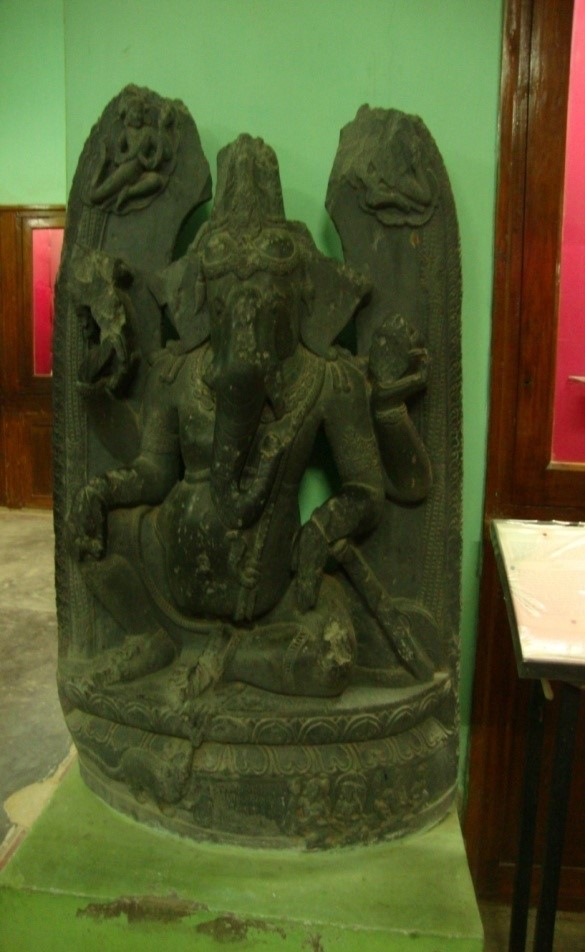
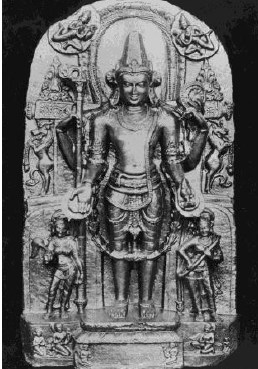
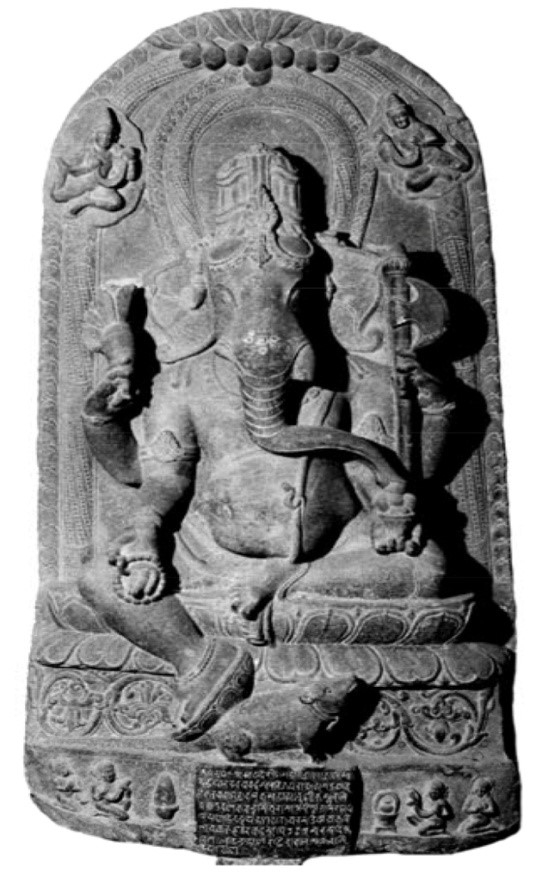
Three Image Inscriptions of the Palas from Kumilla (Bangladesh)
We can close our discussion on image inscriptions with two case studies. One of these is on the social background of the donors of the images at the Kurkihar Monastery of Bihar. An institution-wise study of the background of donors of inscribed images may help us in understanding the pattern of patronage, towards the establishment, and its social base together with the nature of its interaction with outsiders. A century-wise analysis of the pattern of donation of images to the monastery shows that between the eighth to the twelfth centuries, among the 37 stone images, the monks donated eight images while lay worshippers donated only one. Among the 56 donations in metal, monks made 10 donations and lay worshippers made five. The Buddhist monks and the lay worshippers, therefore, definitely made substantial number of donations but together with them the other occupational sub-castes, like Charmmakara (leather-worker), Tailika (oil miller), Kayastha (scribe), and local people joined hands to maintain the popularity of the site. This study throws some light on how the Buddhist monasteries were maintaining a relationship of interdependence with their neighbouring villages. Besides that, it also hints at the role of the monastery in spreading the popularity of the Buddhist deities among the villagers, since a sizeable amount of donations were made by the local people.
Another study on the distribution of merchant-donated images in the period between eighth to the thirteenth centuries in eastern India shows that they are largely concentrated in two areas: 1) south Bihar and 2) south-eastern Bangladesh. In south Bihar, the existence of the urban and administrative centre of Krimila adisthana and visaya (the area around Valgudar and Lakhisaraiin Bihar) might have been a factor for the presence of merchants. Besides, we have the overwhelming importance of its sites as places of pilgrimage popular among the Buddhists. Again, south-eastern Bangladesh as a sub-region was very active in trade in the Early Medieval period.[11] Being a hinterland to the port of Samandar, which flourished from the ninthcentury onwards, the traders had a strong presence in the society. This explains the presence of affluent merchant families at Bilakindaka, as recorded in the image inscriptions discussed earlier.
Conclusion
To sum up, image inscriptions, though brief in nature, contain abundant data on cultural history. Why did people donate images? The primary aim was to gain religious merit and also to record the event of their visit to sacred places. The other kind of donation made for religious merit in early India was the donation of land. However, it was very expensive, and in order to ensure tax exemptions, on the gifted land for the recipient, the donor had to approach the state. This could have been a complex process. It is probably for this reason that we find merchants, craftsmen and other people of the society donating images. Aspiration for social status urged them to donate images, since neither the merchants nor the artisanal groups were accorded a high position in the normative texts, like the Dharmasastras, by the Brahmanical authors. Thus, craftsmen like Tailika, Suvarnakara, Karmmakara and others must have found donation of images to be a fulfilment and manifestation of devotion to their gods and goddesses.
Notes
[1] Sircar, Select Inscriptions Bearing on Indian History & Civilization, 93–4.
[2] Huntington, The Pala-Sena Schools of Sculpture, 207.
[3] Bhattacharya, Essays on Buddhist, Hindu, Jain Iconography and Epigraphy, 223–32.
[4] Ibid.
[5] Mishra and Ray, The Archaeology of Sacred Spaces: The Temple in Western India.
[6] Sengupta, ‘Donors of Images in Eastern India (c.800-1300 A.D).’
[7] Huntington, The Pala-Sena Schools of Sculpture, 57.
[8] Asher, ‘Sculptures from Rajaona, Valgudar and Jaynagar.’
[9] Asher, ‘Stone and the Production of Images.’
[10] Asher, ‘The Effect of Pala Rule: A Transition in Art.’
[11] This factor has been dealt with in detail by Suchandra Ghosh. See Ghosh, ‘Economy of Samataṭa in the Early Medieval period.’ For further discussion on image inscriptions from eastern India, see Gupta, Patna Museum Catalogue of Antiquities; and Picron, The Forgotten Place.
Bibliography
Asher, F. ‘Sculptures from Rajaona, Valgudar and Jaynagar: Evidence for an Urban Centre.’ East & West 36, no.1/3 (September 1986): 227–46.
Asher, F. ‘Stone and the Production of Images.’ East & West 48, no.3–4 (December 1998): 313–28.
Asher, F. ‘The Effect of Pala Rule: A Transition in Art.’ Journal of the Indian Society for Oriental Art XII, XIII (1981–83, 1985): 1–7.
Bhattacharya, G. Essays on Buddhist, Hindu, Jain Iconography and Epigraphy (Studies in Bengal Art Series). Dhaka: ICSBA, 2000.
Ghosh, Suchandra. ‘Economy of Samataṭa in the Early Medieval period: A Brief Overview.’ In Prajñādhara: Essays on Asian Art, History, Epigraphy and Culture in honour of Gouriswar Bhattacharyya, edited by Gerd G.R. Mevissen and Arundhati Banerjee, 352–68. New Delhi: Kaveri Books, 2009.
Gupta, P.L. Patna Museum Catalogue of Antiquities. Patna: Patna Museum, 1965.
Huntington, Susan L. The Pala-Sena Schools of Sculpture. Leiden: E.J. Brill, 1984.
Mishra, S.V., and H.P. Ray. The Archaeology of Sacred Spaces: The Temple in Western India, 2nd century BCE-8th century CE. Routledge, 2017.
Picron, C.B. The Forgotten Place: Stone Images from Kurkihar, Bihar. New Delhi: Archaeological Survey of India, 2014.
Sayantani pal_ Biblio
Sengupta, G. ‘Donors of Images in Eastern India (c.800-1300 A.D).’ Proceedings of Indian History Congress 43 (1982): 158–64.
Sircar, D.C. Select Inscriptions Bearing on Indian History & Civilization. Kolkata: Calcutta University, 1965.
